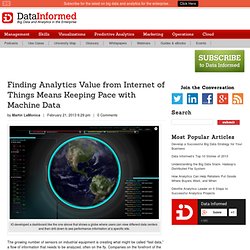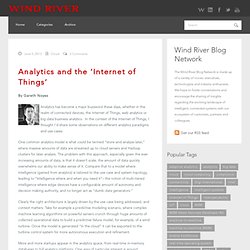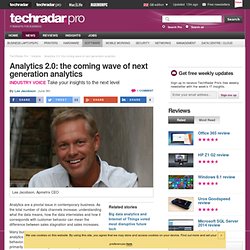

Data Analytics and the Ubiquitous Internet of Things. In a world where the Internet of Things (IoT) produces massive amounts of data from mobile devices, vehicular systems and environmental sensors, data scientist will be tasked with what to do with all of this information.

We sat down with Cristian Borcea, PhD from the New Jersey Institute of Technology to discuss the IoT and Big Data applications. insideBIGDATA: It seems we can’t turn on the television or read a newspaper without encountering the phrase, the “Internet of Things”. Aside from being a marketing term, what does this really mean? Cristian Borcea: The emerging Internet of Things (IoT) consists of heterogeneous computing and wireless communication systems embedded in the physical environment.
Internet of things, Big Data and Analytics 101. Finding Analytics Value from Internet of Things Means Keeping Pace with Machine Data. IO developed a dashboard like the one above that shows a globe where users can view different data centers and then drill down to see performance information at a specific site.

The growing number of sensors on industrial equipment is creating what might be called “fast data,” a flow of information that needs to be analyzed, often on the fly. Companies on the forefront of the Industrial Internet say analytics systems can squeeze tangible benefits from a flow of machine data. Energy management software company EnerNoc has been handing data from utility meters, its controllers and buildings management systems for a decade.
Earlier this month, it said it started using predictive analytics software from artificial intelligence startup Numenta, part of an effort to use cutting-edge analytics tools to increase revenue. Called Grok, Numenta’s software analyzes data from utility meters to predict how reliably an EnerNoc customer will participate in a request to lower energy use in two hours. The Internet of Things and real-time analytics. Joseph Schumpeter, one of my favorite economists, coined the term "creative destruction" to describe the way in which innovation disrupts how things are done, and in the process, gives rise to new companies and new ways of operating. What's been called the Internet of Things -- the rapidly proliferating connection of all devices, sensors, machines and people -- is set to create disruption on a huge scale.
This ups the ante significantly for analytics and real-time computing. The driverless car is an excellent example as a disruptive innovation that impacts both consumers and businesses. For instance, when driverless cars become common, not only will they change commuters' experiences, they are expected to lessen the incidence of traffic accidents, improve the density of road use, smooth subsequent planning for maintenance, ease long-term planning for other transportation systems such as light rail, and much more.
What makes all of this possible? It is only human nature. Analytics and the ‘Internet of Things’ By Gareth Noyes.

Internet of Things Analytics(tm) Do you know what your connected customers are doing right now?

Most manufacturers know more about casual visitors to their website than about customers using their products. Using Internet Analytics, Companies can tell what visitors are looking for (and what they aren't), where they came from, how long they stay on any particular link and where they went next... and those are the most basic, basic details. On the 'Internet of Things' and the rise of predictive analytics. By Paul Newman Jun 6 2014, 01:20 AM Data is everywhere in our modern society.

And while many companies out there may think they're doing everything in their power to take advantage, the odds are good that they could still be doing more. Analytics is a rapidly growing field. While numerous organizations are already doing plenty to gather information about their customers and analyze it to achieve better results, the growth of technology is constantly presenting new options.
For example, think of how the mobile revolution affected the analytics climate. More developments like this are still coming. Here comes the "Internet of Things" Optimism abounds that as more and more of our household devices come online, we'll see an increased potential for real-time data mining, according to FCW. "Real-time situational awareness is a powerful new tool that can create high-performance programs operating on a solid foundation of continuous effective decision-making," Rubel stated.
Analytics 2.0: the coming wave of next generation analytics. Analytics are a pivotal issue in contemporary business.

As the total number of data channels increase, understanding what the data means, how the data interrelates and how it corresponds with customer behavior can mean the difference between sales stagnation and sales increases. Many businesses, however, remain locked into the world of analytics 1.0 and surface level data, such as in-app behavior. Even worse, some businesses are still concerned primarily with offline analytics related to TV spots, radio and print ads. Analytics 2.0 offers a path to a more meaningful, actionable understanding of business data.
Both offline and analytics 1.0 focus on single stream analysis. What can analytics 2.0 do? Analytics 2.0 does away with single-stream analysis and embraces the multi-channel world that customers actually inhabit. Analytics 2.0 aims to take these disparate streams of information and turn them into something useful.